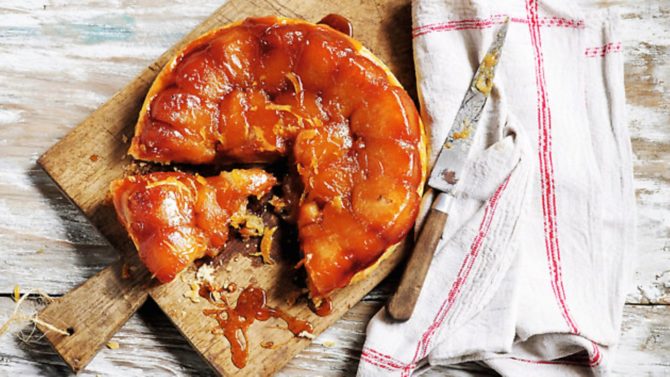Tarte Tatin recipe

Food writer Mary Cadogan shares her recipe for tarte Tatin and reveals the origins of the dessert
A really good tarte Tatin is a thing of beauty and one of the best desserts imaginable. And if the story is to be believed, it was created quite by accident. In the late 19th century, two sisters, Caroline and Stéphanie Tatin, ran a hotel in the small town of Lamotte-Beuvron in the Sologne area of central France. Stephanie was renowned for being a little scatterbrained, and one day she left the apples for her tart cooking too long, causing them to caramelise. Rather than waste the apples, she quickly topped them with a sheet of pastry and put the whole lot in the oven. She then turned the whole thing upside down and, as with many happy accidents, a new recipe was born. Word travelled to Paris and the chef at Maxim’s went in disguise to investigate, returning with the recipe, which he promptly put on the menu and named it Tarte de demoiselles Tatin.
As with all simple recipes, the choice of ingredients is the key to success. The apples must be firm and slightly sharp to balance the sweetness of the caramel. Suitable French varieties would be Reine des Reinettes or Belle de Boscoop, but in England my top choices would be Cox or Russet. Cooking apples are not suitable as they do not keep their shape when cooked. The pastry can be shortcrust or puff – personally I prefer puff for the crisp flaky finish it gives to the tart. As for the tin, most recipes require a special pan that is suitable for both hob and oven, but I prefer to caramelise the apples in a heavy frying pan before transferring them to a cake tin and topping with pastry ready for the oven. For the best flavour, choose all-butter puff pastry and if you can find it ready rolled in a round, then life gets even easier. Purists serve tarte Tatin without embellishment, but I find a scoop of quality vanilla ice cream or a good dollop of Chantilly cream finishes it off a treat. The choice is yours.
Tarte Tatin Recipe
Serves 6
Ingredients
375g pack all-butter puff pastry, or a 230g round of ready-rolled, all-butter puff pastry
6 eating apples
Juice of 1 lemon
150g caster sugar
75g butter
Method
1. Have ready a 23-24cm shallow cake tin, preferably non-stick but not loose based.
2. Peel, core and quarter the apples, put into a bowl with the lemon juice and toss them around to coat them. Sprinkle the sugar over a large, heavy-based frying pan and add 6 tbsp cold water.
3. Heat the sugar and water gently, stirring until the sugar has dissolved, then stop stirring and increase the heat. Boil hard until the syrup is a caramel colour, then add the butter, cut into small pieces, stirring well until you have a caramel-coloured sauce.
4. Spoon about 6 tablespoons of the caramel into the tin. Add the apples and their juices to the pan and stir to coat all the apples. Cook for 5 mins stirring occasionally until the apples have started to soften.
5. Using a large spoon and fork, carefully arrange the apples in the tin, packing them in sideways as tightly as possible. Pour the remaining sauce from the pan into the tin. Leave to cool for 15 mins. Heat the oven to 200°C (fan oven 180°C), Gas mark 6.
6. Roll out the pastry and trim it to a round slightly larger than the tin. Put the pastry on top of the apples, tucking it in around the edges. Bake for 35-40 mins until the pastry is crisp and golden.
7. Remove from the oven and leave to cool for a few minutes. Ease the edges of the pastry away from the edges of the tin. Place a large heatproof plate over the tin and quickly turn over the tin and plate. Lift off the tin to reveal the golden apples and syrupy sauce. Serve with whipped cream or good vanilla ice cream.
Why not try our recipe for îles flottantes?
Share to: Facebook Twitter LinkedIn Email


